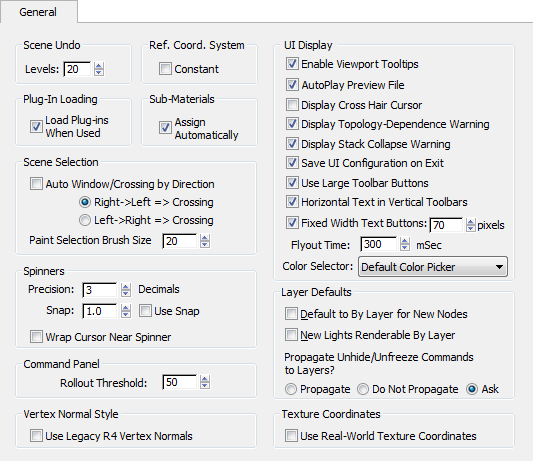On the General panel of the Preference Settings dialog, you set options for the user interface and for interactivity.
To set and toggle spinner snap:
 Preferences
Preferences  Preference Settings dialog
Preference Settings dialog  General tab.
General tab.
 (Spinner Snap).
(Spinner Snap).
Either method brings up the General tab. The two controls for spinner snap are in the Spinners area of this panel.

Reference Coordinate System group
Sets one coordinate system and transform center for Move, Rotate, and Scale on the Main toolbar. The coordinate system displayed in the coordinate dropdown list, and the transform center selected from the Use Center flyout, are used for all transforms.
Normally, each transform switches to the coordinate system and transform center used the last time the transform was active.
Starts the Media Player automatically at the end of a Make Preview.
Displays the mouse cursor as full-viewport cross hairs, vertical and horizontal lines extending the full extent of the active viewport.
Each movement of the mouse is redrawn, so the cross hairs are relatively slow. If you want to create a keyboard shortcut,
find Cross Hair Cursor toggle in Customize menu  Customize User Interface
Customize User Interface  Keyboard panel and specify the keys to use for the shortcut. To change the color of the cross-hairs cursor, go to Customize
menu
Keyboard panel and specify the keys to use for the shortcut. To change the color of the cross-hairs cursor, go to Customize
menu  Customize User Interface
Customize User Interface  Colors panel
Colors panel  Viewports
Viewports  Cross Hair Cursor and use the color selector to change the cursor color.
Cross Hair Cursor and use the color selector to change the cursor color.
Toggles the topology dependence warning. This warning appears when you choose to edit a modifier or the base object at the bottom of the modifier stack of an object with modifiers and sub-object selections. The warning occurs because this action can affect the object topology adversely. You can also turn off the warning on the warning dialog. Default=on.
Specifies the maximum width of text buttons.
To use this feature, turn on the Horizontal Text In Vertical Toolbar switch, turn on this option, and then set a maximum display size for the text button in pixels. For custom vertical toolbars with text buttons, this option limits the size of the text display.
Choose the default color selector, or a third-party plug-in color selector in the list. The color selector you choose here is used throughout 3ds Max whenever you specify a color.
Enables the automatic creation of a Multi/Sub-Object material when you assign a material to a selection of face sub-objects in an editable object. Default=on.
When on, the assigned material becomes part of the new Multi/Sub-Object material, and is assigned to the face selection. When off, the assigned material is assigned to the entire object.
When on, the direction that you drag a selection area determines whether it is a window or crossing selection. This works for any selection area (rectangle, circle, fence, or lasso).
You can select which direction causes a window selection and which causes a crossing selection in the Scene Selection group. When you drag a window selection, the selection region is displayed with a solid line; when you drag a crossing selection, the selection region is displayed with dashed lines.
Sets the size of the brush used by Paint Selection Region .
When on, 3ds Max sets rendering, motion blur, display, and advanced lighting properties for all new objects to By Layer.
When on and you create a light, 3ds Max gets its Object Properties Renderable setting from the properties of the active layer.
Renderable setting from the properties of the active layer.
When you unhide or unfreeze an object on a hidden or frozen layer, this choice determines whether the command affects the object or its layer.
Controls whether real-world texture coordinates are active or if the legacy method of applying texture coordinates is in use. When off, texture-coordinate behavior reverts to the legacy method and texture tile values have a default value of 1, and Real-World Map Size for primitives is off. Default = off for 3ds Max, on for 3ds Max Design.
When Use Real-World Texture Coordinates is on, the Use Real-World Scale (for 2D maps) and Real-World Map Size options are also on. Real-World Map Size is available for objects such as primitives and modifiers such as UVW Map.